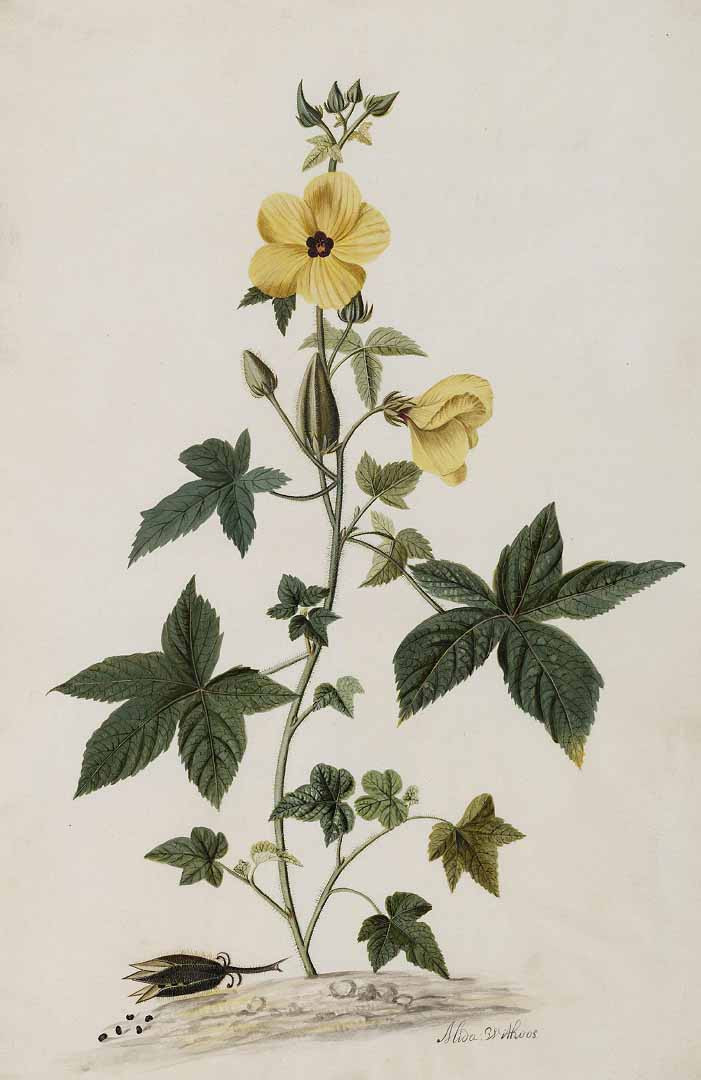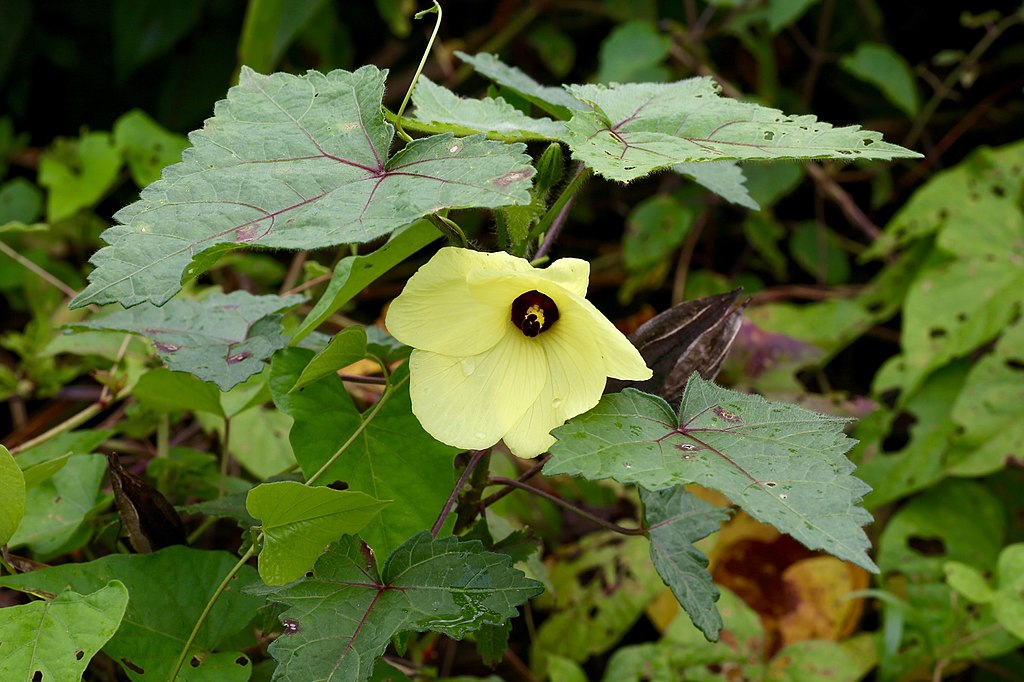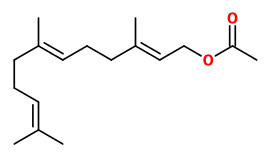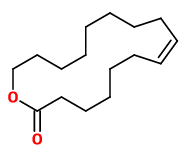Abelmoschus moschatus Medik. - Malvaceae - syn.Hibiscus abelmoschus L.; Bamia abelmoschus R.Br. - Malvaceae
musk okra, musk mallow, tropical jewel-hibiscus, ambrette (fr.), Moschus-Bisameibisch
Hispid annual or biennial, up to 1.25 m tall; grown in warm countries for the musk-fragrant seeds and the showy yellow crimson-centered axillary fls. which are about 4 in across; leaves various, usually with deep divaricate narrow strongly and irregularly toothed lobes, but some of them shallowly lobed and maple-like, all sparsely hairy on both surfaces; bracts linear, much shorter than the spathaceous many-toothed caducous calyx; fruit oblong-acuminate, hairy, 3 in. or less long.
„The seeds have a sweet, flowery, heavy fragrance similar to that of musk (hence its specific epithet moschātus, scientific Latin for ‘musk’).“ http://en.wikipedia.org/wiki/Abelmoschus_moschatus
Ambrettolide as the fragrant principle was isolated by fractionation of ambrette seed oil.
[Kerschbaum, M. „Über Lactone mit großen Ringen - die Träger des vegetabilischen Moschus‐Duftes.“ Berichte der deutschen chemischen Gesellschaft (A and B Series) 60.4 (1927): 902-909]
The macrocyclic musk compound (Z)‐5‐tetradecen‐14‐olide, together with (Z)‐5‐dodecenyl acetate, and (Z)‐5‐tetradecenyl acetate have been isolated from the absolute oil of Hibiscus abelmoschus L.
[Maurer, Bruno, and Alfred Grieder. „(Z)‐5‐Tetradecen‐14‐olide, a New Macrocyclic Lactone, and Two Unsaturated Straight Chain Acetates from Ambrette Seed Absolute.“ Helvetica Chimica Acta 60.4 (1977): 1155-1160]
Main components of the monoester fraction of ambrette (Hibiscus abelmoschus seeds) were (E,E)-2,6-farnesyl acetate (70%), (Z,E)-2,6-farnesyl acetate (6%), (Z)-7-hexadecen-16-olide (natural ambrettolide, 12%) and (Z)-9-octadecen-18-olide (oxacyclononadec-10-en-2-one, 4.5%).
„These compounds are localized in the outer layers of the seed coat, but are not epicuticular. They are deposited in the seed coat after seed coat dry weight accumulation has essentially stopped, but at the same time as embryo dry weight and neutral lipid are increasing.“
[Seed coat components of Hibiscus abelmoschus., Nee, T.Y., Cartt, S., Pollard, M.R., Phytochemistry, 25(9), 1986, 2157-2161]
The commercial extract or essential oil (hydrodistillation) from ambrette seeds is long been used in perfumery for its sweet, floral-musky, winelike odor. A mechanic separation of the water-soaked seed coats followed by alcoholic extraction and liquid-liquid extraction of the oleoresin obtained after removal of the alcoholic solvent with pentan or hexan, and removing fatty acids over a short column, led to an extract (0.24-0.29%) with sweet-smelling and lasting odor, almost free from fatty acids. Main components of this extract were decyl acetate (5.7%), dodecyl acetate (5.1%), farnesene (9.6%), (Z)-5-tetradecen-14-olide (1.3%), (Z)-5-tetradecenyl acetate (1.2%), (Z,E)-2,6-farnesyl acetate (3.8%), (E,E)-2,6-farnesyl acetate (50.4%), (Z)-7-hexadecen-16-olide (9.3%), (Z)-9-octadecen-18-olide (1.2%).
[A Novel Process for the Extraction of Fragrance Components from Ambrette (Hibiscus abelmoschus L.) Seeds. P. K. Rout , K. C. Barik , K. S. Jena , D.Sahoo, and Y. R. Rao, Org. Proc. Res. Dev., 2002, 6 (4), pp 401–404]
http://cdn-pubs.acs.org/doi/abs/10.1021/op0200017
The plant is cultivated for essential oil from the seeds, which has a musk-like odor and is used in perfumery. The seeds itself were formerly considered stimulant and antispasmodic. The tincture and the volatile oil are widely used in cosmetics like creams, lotions and soaps and as a food flavor. The seeds contain 14.5% fatty oil and 0.2-0.6% volatile oil, starch, methionine sulfoxide and phospholipids. Main constituents of the semisolid pale yellow volatile oil, extracted by steam distillation, are farnesol (42.3%) and ambrettolide (14.8%, omega-6-hexadecenlactone, lactone of ambrettolic acid), which is responsible for the musk-like odor.
[Extraction of ambrette seed oil and isolation of ambrettolide with its characterization by 1H NMR., Nautiyal, O.H., Tiwari, K.K., J. Nat. Prod, Vol.4, 2011, 75-80]
http://journalofnaturalproducts.com/Volume4/12_Res_paper-11.pdf

Hibiscus moschatus (Medik.) Salisb. as Abelmoschus moschatus Medik.
Moninckx, J., Moninckx atlas, vol.4 t.25 (1682-1709)
http://www.plantillustrations.org/species.php?id_species=508

Abelmoschus moschatus, Ecuador (2016), Author: yakovlev.alexey from Moscow
CC BY-SA 2.0 Wikimedia Commons


